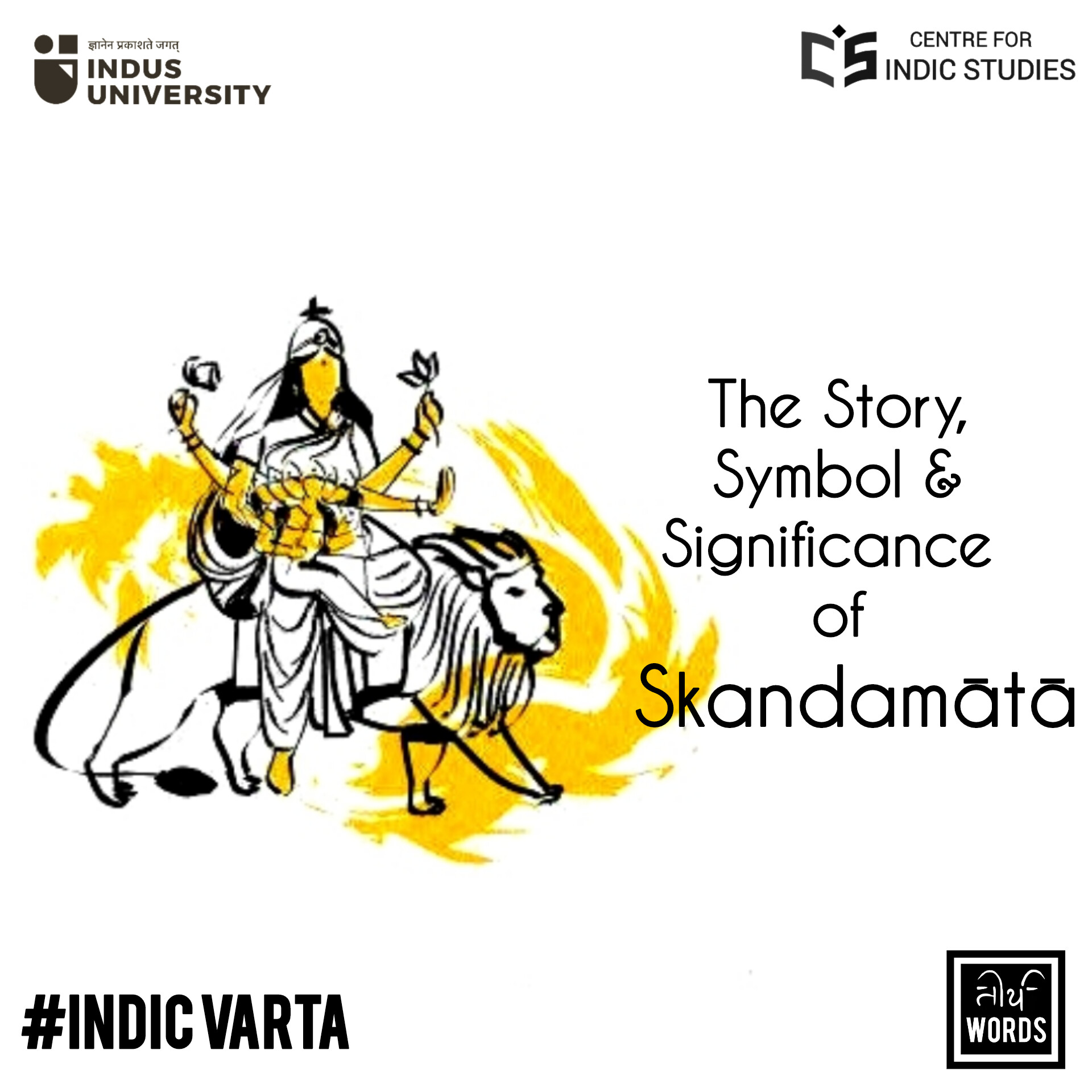- Visitor:142
- Published on: 2024-10-07 12:47 pm
The Story, Symbol, and Significance of Skandamātā
Worshipping Skandamātā has two-fold benefits: blessings from Skanda and blessings from the devī, the former representing strength and protection from evil and the latter representing motherly care and affection.

Story
When Kūṣmāṇḍā gave birth to the cosmos, she became the cosmic mother. The entire clan of the devatās exhorted in delight. She had not only given birth to the cosmic spheres of their governance, but also to the subjects who are to be ruled. All was set and everyone was happy. Until the devī willed to be mother again. She solicited her husband and succeeded in convincing him. They embraced each other and dribbled into the cosmogonic coitus. However, the devatās were frightened at this since they would have an equal or more powerful competitor if another cosmos was to emerge and be given to other supernatural beings to rule. So, they went to Brahmā and pleaded him to intercept the aftermath. He went to the divine couple, beseeching them to abstain from the act. Śiva, being a symbol of magnanimity, yielded to their request.
However, the cosmic semen from Śiva took the form of Agni who later became the lord of fire and energy and the ovum from Pārvatī took the form of Svāhā who later became the radiance of auspice. In the course of time, Agni and Svāhā entered into the existing cosmos, enabling all possibilities of sustenance. When mankind was projected into the world, they were asked to perform yajña by chanting Svāha’s name while making oblations to the fire. As they both emerged from the purest masculine and the purest feminine, they are considered to be the means of purification. Since Agni and Svāhā are eternal companions, they accepted each other as their spouses.
Meanwhile, the devatās were in trouble since they were incessantly tormented by the dānavas. They needed a leader of their army who would be valorous enough to vanquish the enemy. So, they requested the duo to produce an offspring. When Svāhā was inseminated by Agni, her womb was highly smouldered. She requested Gaṅgā to carry the zygote as a surrogate mother. The latter promised to carry the pregnancy but denied to rear the child after birth. When the baby was born, he was offered to the six cursed wives of the Saptarṣi sages who were promised redemption once they would bring the child up, breastfeeding it. As they were six in number and the new-born was extremely hungry, the boy appeared with six heads to suck the milk from the breasts of his six foster mothers. Later, as the child grew up to adolescence, it was named Skanda and his valour was unmatched. Impressed by him, Indra, the king of the deities, offered him the position of the leader of the army. The deities together implored the devī to reveal to him the true origin of his birth and accept him as her son. The devī was in tears to finally have her long-cherished desire of having a son of her own. She took Skanda upon her lap and fondled him to her heart’s content. Happy to see the union of the mother to her separated son, the deities named her Skandamātā.
Symbol
As a representation of maternal love, Skandamātā inspires devotion and reverence. She teaches the importance of selflessness, sacrifice, and unconditional love, values deeply rooted in the concept of motherhood. Her worship invokes the qualities of patience, compassion, and the strength to face challenges, reminding devotees of the transformative power of maternal affection.
In iconography, Skandamātā is depicted holding her son in her lap, often radiating a serene and loving presence. This image encapsulates the essence of unconditional love and support that a mother provides. Her four arms represent different aspects of nurturing: one hand holds a lotus, symbolizing purity and spiritual enlightenment; another holds a bell, signifying the call to dharma; the third hand bestows blessings, and the fourth hand offers refuge. This imagery highlights her role as a guide and protector, emphasizing that motherhood extends beyond mere biological connections to a broader spiritual significance.
Significance
Worshipping Skandamātā has two-fold benefits: blessings from Skanda and blessings from the devī, the former representing strength and protection from evil and the latter representing motherly care and affection. Firstly, devotees receive the blessings of Skanda, her divine son, who embodies strength, valour, and protection against malevolent forces. As a formidable warrior and leader of the celestial army, Skanda symbolizes the courage to confront adversities, instilling a sense of fearlessness in his followers. His presence assures devotees of their protection and empowers them to triumph over challenges.
Secondly, as the cosmic mother, Skandamātā epitomizes maternal care, offering solace and guidance to those who seek her blessings. Her affection provides profound emotional support, fostering a deep sense of security and warmth. By propitiating Skandamātā, devotees cultivate resilience while basking in the unconditional love of a mother. This sacred relationship enriches their lives, reinforcing the belief that they are never alone in their struggles, fostering both inner strength and emotional well-being. Therefore, let us pray to Skanda and his mother and seek their blessings simultaneously by chanting:
ॐ सिंहासनगता नित्यं पद्माश्रितकरद्वया।
शुभदास्तु सदा देवी स्कन्दमाता यशस्विनी॥
या देवी सर्वभूतेषु माँ स्कन्दमाता रूपेण संस्थिता।
नमस्तस्यै नमस्तस्यै नमस्तस्यै नमो नम:।।
॥ ॐ देवी स्कन्दमातायै नमः ॥
- 71 min read
- 3
- 0







.jpg)


